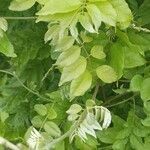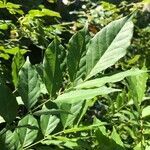A climber which can grow 6-9 m long. It can climb over trees 20 m high. The leaves are light to mid green and composed of up to 19 leaflets. The flowers are violet-blue. The flowers are fragrant. The flowers are in drooping racemes 30 cm long. They taper along the length. There are several named varieties.


